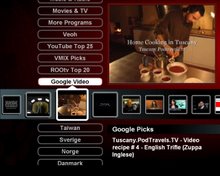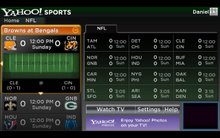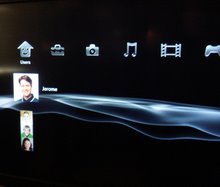The Issue: The notion of selling a PC attached to the TV in the living room was stillborn in the market some time ago. Intel has just now announced its passing, little surprise to anyone familiar with how most consumers really use these products. Given Intel’s announcement, is it now safe for the cautious reporter to write about what was an inevitable demise?
Solutions: No sense throwing the baby out with the bath water. Enthusiasm for Internet-based video viewable on TVs throughout the home remains undiminished, regardless of whether Intel puts a halt to promoting the living room PC. The only way forward is in combining what is best about the PC with what is best about the TV: The PC should serve as the software work horse engine for the TV, as required, while the TV benefits from remote access to Web 2.0 technologies & features without having to manage any of the complexity or grapple with unforeseen future technical obsolescence.
Behind the scene: With delusions of grandeur, PC-industry executives' ambition lay somewhere between unreasonably optimism and wanton incompetence in believing that a PC running a Windows operating system could bring a cost-effective and stable ‘experience’ when integrated into the TV. Their failed efforts, moreover, set back needlessly the adoption of thin-client technology and opportunities to bring to the living room the immersive software and web experience of the PC which is still found lacking on the TV.
PC companies like Intel, Microsoft and AMD have for several years now sought to promote sales of PCs connected to the TV in the living room. Brands such as Intel Viiv, Windows Media Center Edition (MCE) and AMD LIVE! remain associated with these efforts. Despite the look of a sleek DVD player, or the feel of a high-end home theater console, these PCs never met much consumer enthusiasm. Facing the inevitable, news reports indicate that Intel has now decided to, “Scale Back on Viiv Digital Living Room Branding”.
Central to this failed endeavor was the notion that placing a PC in the “critical path” of the content flow [i.e. routing the TV signal first through the PC] would somehow be mutually beneficial to both PC vendor and ‘content’ owner alike; whereas in reality it simply increased the risks without bringing much benefit. First, Intel was forced to “work with content companies to certify that movies and other video fare delivered over the Internet worked well with a remote control and looked good on a TV screen,” an endless and needless effort. Second, contrary to conventional, if flawed, reasoning [and as I have been pointing out for several years now], a PC is not really required to access video over the Internet. There are other options, all of them less expensive, and all of them producing less heat, noise, or maintenance issues associated with using a Windows operating system. These facts did not stop management, however, from supporting overly ambitions objectives regardless of the evidence to the contrary.
Also of note, the brands listed above where not only primarily focused on PCs attached to the TV but also confusingly associated with extended-PC plans -- but without explaining how these two approaches were separate. In the case of Intel, the extended-PC approach required use of a Viiv client or an MCE Extender box at the TV location, rather than a Viiv PC connected to the TV.
Apple did not make this mistake with the Apple-TV, which is a client of an Extended-PC or Extended-MAC. Apple has clearly indicated that the Apple-TV is the device to connect to the living room TV.
No doubt the decision to promote the PC-in-living-room by PC industry players was the result of both little experience in marketing consumer appliances and a failure to produce client devices that function well. Those sold to date were Digital Media Adapters (DMA), a device category not readily understood by consumers. Their associated marketing campaigns are now severally criticized by the press and analysts. And yet, Microsoft, undaunted, is about to launch its second generation of Extenders, with a price tag of nearly $350 each, which likely makes these offerings dead on arrival (DoA).
The strategies employed by Intel and AMD, including “Viiv client” and “AMD LIVE! Ready” branding campaigns, have never gotten off the ground, since having failed to recruit to the cause significant numbers of established consumer appliance manufacturers (largely due to onerous branding requirements and meaningless technical specifications), and having championed broadcast reception in the PC (required to keep the PC in the critical path of content flow), these branding programs have inevitably come afoul of consumers. These consumers have no appetite for the cost, attendant technical issues, and networking complexities. As a consequence, broadcast reception technology was never integrated with thin-client technology; and so we find ourselves with DMA client boxes rather than TVs integrated with network and thin-client support.
Compounding these problems, the PC industry has tied Internet video support to premium PC operating systems, in insisting that Windows Media Center rather than basic Windows XP (with its massive installed base) be the requirement to run a Media Center Extender device.
Since progress is never linear when it comes to technology adoption, at this stage in the Internet video development game, there is a market for low-cost DMAs such as the D-Link DSM-520. It is used by early adopters and supports existing TVs which naturally do not have integrated network support. Of course, the DMS-520 works with all widely used PC platforms. Early adopters can use them today to watch lots of varied Internet-delivered video, currently without much advertising support or any expense for content access (no cable TV bill). With this increasingly compelling experience, greater numbers of consumers are eventually going to realize what they are missing. . .
To this end, the alternative active-TV technology approach relies on an Extended-PC only to assist the networked TV or networked STB, when it is needed. Whenever the TV or STB encounter software complexity or require other support (i.e. access to home photos or video stored on the PC, video reformatting, complex UI features and the like), it can call on the PC. Most importantly, the PC is not in the critical path of content flow: A TV or STB client performs traditional TV tasks entirely alone, without PC assistance; in other words regardless of whether or not the PC is turned on or off.
The “complex software” which even the next generation of TV chips cannot support includes advanced UI features and Web 2.0 technology (e.g. mash-ups, widgets, RSS feeds, etc.) – which continues to advance in ways unforeseen, and for which the PC is supremely able to keep in stride. How to help the TV in the living room gain access to ‘the Web 2.0 experience’ remains the central question and has always been the only real task for the PC. In short, it is accomplished via the home network and without a PC connected directly to the TV. It follows that active-TV technology was developed precisely to accomplish this task, and this is why it has gained acceptance among the more traditional TV developers.
While moving away from the living-room-PC, the rumor mill reports that Intel is working on an x86- based TV chip, codenamed Kenmore, of which we are likely to hear more about at CES 2008 (January). Prior attempts to integrate x86 technology into a TV system-on-chip (SOC) have not been successful – but, to be sure, the attempts have been many. Intel nevertheless has made acquisitions to gain access to the necessary technology. It is not clear if the ‘first generation’ will be a multi-chip module. The chip is unlikely to be used with Windows, but will better enable Intel customers to offer standalone support for Web 2.0 technology in a TV. It might even be used in a future Apple TV. Suppliers of non x86-based TV SOCs can still offer complete support for Web 2.0 via active-TV technology integrated directly with their displays and in combination with assistance from a networked PC or laptop.
In conclusion, to some the unassisted “TV goes it alone” approach may appear to have advantages over the “TV with remote PC assistance” one. However, looked at more closely the differences in network support are likely irrelevant as all of these systems are going to be networked regardless of where they are located in the home. Any user of these systems almost certainly already maintains a PC and keeps the web access technology or applications up-to-date (i.e. Flash updates, Java plug-ins, browser add-ons, virus scans, etc.). Relying on PC assistance, therefore, removes the added burden of keeping not just the PC but also the TV software up-to-date. The PC, with its much shorter refresh cycle (2 - 3 years vs. 6 - 10 years for the TV) can always be upgraded in the future and consequently it (or the TVs it supports) will not likely run out of processing power. Lastly, there are likely cost and TV-technology advantages to a TV supplier by continuing to use low-cost and established TV chip suppliers.
Feedback, corrections and comments welcome. Contact me for more information or support with active-TV technology development.
Daniel Mann
Navigate YouTube available at iTunes App Sore
An easy to use iPhone and iPod touch App that enables both new and advanced YouTube users to get the best from YouTube.
Browse video Standard Feeds, Categories, Channels and Playlists. Then organize new videos into your own favorites and playlists. Make playlists private or public. Subscribe to other user's playlists and video collections for future viewing. Subscribe to videos matching search-words.
Look at publicly viewable favorite videos, playlists and subscriptions based on your YouTube friends, family and contacts. Send and receive video links with YouTube contacts via YouTube video messages.
Search for new videos tagged for your language or geographical region, using local keyboard. Explore for new videos via easy switching of user ID to the owner of interesting videos - then explore their world.
All actions are kept in sync with PC, Mac or Apple-TV access to YouTube. Available at Apple App Store.
Browse video Standard Feeds, Categories, Channels and Playlists. Then organize new videos into your own favorites and playlists. Make playlists private or public. Subscribe to other user's playlists and video collections for future viewing. Subscribe to videos matching search-words.
Search for new videos tagged for your language or geographical region, using local keyboard. Explore for new videos via easy switching of user ID to the owner of interesting videos - then explore their world.
All actions are kept in sync with PC, Mac or Apple-TV access to YouTube. Available at Apple App Store.
active-TV technology for PC

Windows PC based home network
Thursday, December 20, 2007
Subscribe to:
Posts (Atom)









